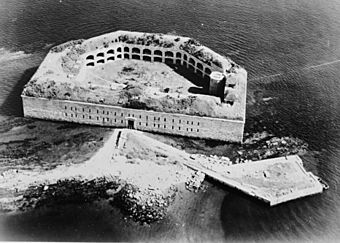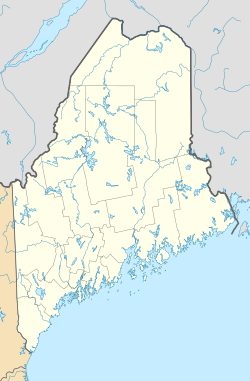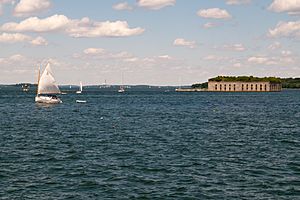Fort Gorges facts for kids
Quick facts for kids |
|
|
Fort Gorges
|
|

Fort Gorges
|
|
| Location | E of Portland on Hog Island, Portland Harbor |
|---|---|
| Nearest city | Portland, Maine |
| Area | 6 acres (2.4 ha) |
| Built | 1858 |
| NRHP reference No. | 73000114 |
| Added to NRHP | August 28, 1973 |
Fort Gorges is an old military fort in Maine, built on a small island called Hog Island Ledge in Casco Bay. It was constructed between 1858 and 1864. Even though it was a fort, no battles ever happened there, and no soldiers were ever stationed inside it. New military inventions, like strong ships made of iron and powerful long-range cannons, meant the fort was outdated even before it was finished. Today, Fort Gorges is a public park, and you can only get there by boat. It became a recognized historic place in 1973.
Contents
Fort Gorges: A Look Back
After the War of 1812, the United States Army wanted to build a new fort. They chose Hog Island Ledge in Casco Bay. This spot was perfect for guarding the entrance to Portland, Maine's harbor. The fort was part of a big plan to protect the US coast.
Why Was Fort Gorges Built?
The fort was named after Sir Ferdinando Gorges, an early owner of land in Maine. It was meant to help other forts nearby. These included Fort Preble in South Portland and Fort Scammel on House Island. Fort Scammel had been built much earlier, in 1808.
However, the government didn't give money for Fort Gorges until 1857. Building the fort's walls began the next year. When the American Civil War started in 1861, work on the fort sped up.
Who Designed and Built It?
Colonel Reuben Staples Smart designed Fort Gorges. The main architect who oversaw the building was Thomas Lincoln Casey. He later became a very important engineer for the Army. Fort Gorges is similar in size to Fort Sumter, another famous fort. But Fort Gorges was built using strong granite stone, not brick.
A Fort Too Late
The fort was finished in 1865, just as the Civil War ended. By this time, new powerful explosives and cannons had been invented. This meant the fort was already old-fashioned when it was completed.
A plan to update the fort began in 1869. But the money for this project stopped in 1876. Because of this, the third level of the fort was never fully finished. During the update, workers added sod-covered sand to the top. This was to protect the gun areas and powder rooms from attacks.
The Fort's Weapons
Fort Gorges was supposed to have thirty-four large 10-inch Rodman guns. These cannons were mounted inside the fort's strong walls. In 1898, almost all the guns were taken away.
However, one very large 300-pounder Parrott rifle was left on top of the fort. It was not mounted, but it is still there today. This cannon is one of the biggest Civil War-era guns still existing.
Later Uses and Today
The Army last used Fort Gorges during World War II. It was used to store mines for submarines.
In 1960, the city of Portland took over the fort. It was added to the National Register of Historic Places in 1973. Now, Fort Gorges is a public park. You can only visit it by private boat or a special water taxi. Visitors should bring a flashlight if they want to explore the dark powder rooms. The fort needs some repairs to keep it safe.




